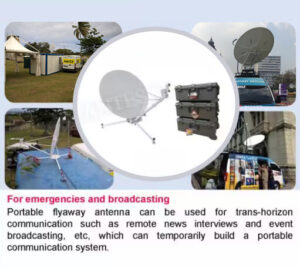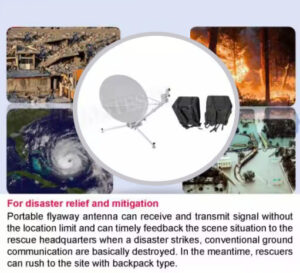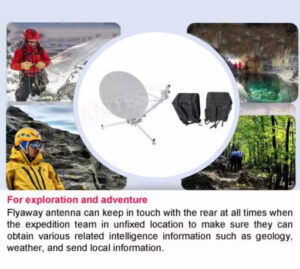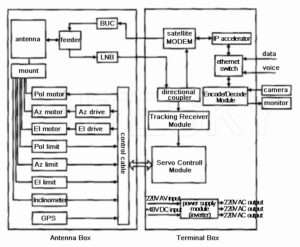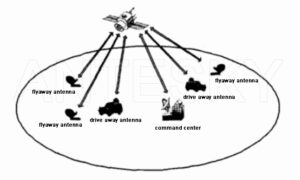
In emergency disaster relief, keeping communication smooth is an important condition to reduce disaster losses and reduce the impact of disasters, and satellite mobile communication is an effective means to ensure smooth communication. As an economical, practical and reliable emergency communication mode, portable flyaway antenna plays an important role in the application of satellite mobile communication in emergency and disaster relief.
Through previous blogs, we have introduced the portable flyaway antenna in detail, including flyaway antenna types, its packaging method, classic cases of previous portable flyaway projects around the world, and a collection of installation videos. Among them, regarding the application of portable station antennas, we mainly listed the general application of portable station antennas, including news broadcasting, expedition applications and disaster relief emergency communications, among which the most widely used is emergency communications in disaster relief. Today we will analyze the working principle, networking mode and characteristics of the portable station in emergency relief in this article. For details, please continue reading as follows.
General applications of portable flyaway antennas
- Business (Remote office video meeting, telemedicine)
- Defence (Police remote command and border communication)
- Emergency communication (Disaster relief, adventure and exploration)
- Media (Event broadcasting and breaking news interview)
- Energy distribution (Oil and gas exploration networks)
1 System composition and work principle of portable flyaway antenna satellite communication
Portable satellite communication earth station is a satellite communication system that meets the requirements of emergencies in special environments, and can be carried manually by hand or on the back. It forms a satellite communication link with the remote main station through the satellite, and performs data communication, voice communication, image communication and other business transmissions according to actual needs.
1.1 System Composition of portable flyaway antenna satellite communication
The flyaway antenna system consists of an assembled reflector antenna, a combined feed, a low-noise down-converter (LNB), an up-conversion power amplifier component (BUC), an antenna pedestal and an antenna servo module, a tracking receiver module, a satellite communication module, and an image encoder module, power supply module and other equipment. The principle of the system is shown in Figure 1.
Fig.1 Portable flyaway antenna system diagram
1.2 Working principle of portable flyaway antenna satellite communication
When using a portable satellite communication earth station, first open the antenna box, manually assemble the main reflector of the antenna, connect the cables between the boxes and turn on the power.
After the device is turned on, the antenna servo control module determines the position of the antenna and the attitude of the antenna pedestal through the inclinometer and GPS, calculates the best polarization matching angle for the satellite beam, and controls the polarization motor to make the polarization angle of the antenna matches the polarization angle of the satellite beam. At the same time, the antenna servo control module drives the azimuth and elevation motors according to a certain automatic control algorithm to search for the satellite beacon beam. The portable satellite communication flyaway antenna adopts the combination of open-loop search and closed-loop tracking for satellite searching. In the open-loop search process, the servo system first sets the tracking receiver to the preset beacon signal frequency according to the beacon frequency of satellite, and at the same time rotates the elevation of the antenna to theoretical calculation value, after the elevation angle is basically determined, according to the tracking theory, the satellite corresponding to the preset beacon frequency can be found by rotating the azimuth, which is the satellite.
After the antenna receives the signal from the satellite beacon, it is amplified by the LNB and divided into two channels by the directional coupler, and one signal is output to the tracking receiver to complete the detection, filtering and amplification of the signal, and provide signal level indication for the servo control. Adjust the attitude of the antenna so that the antenna receives the maximum signal level, that is, the antenna beam is aimed at the satellite. At this time, the antenna enters the step tracking state. In the step tracking state, when the signal is greater than a certain preset threshold, the antenna pointing is in the hold state; when the signal is smaller than the preset threshold, the antenna automatically enters the step tracking state, and the servo control module ensures that the antenna pointing is always aligned by adjusting the antenna attitude Satellite, maintain optimal reception performance. The other signal is transmitted to the baseband unit after being down-converted and demodulated, and then output to the user terminal after baseband processing. At the same time, the output signal of the user terminal is processed by the baseband unit, then modulated, up-converted, and then transmitted to the satellite through the antenna through the power amplifier. So far, a complete satellite communication link has been established. Through the satellite link, the portable satellite communication earth station can carry out various business transmissions with the remote station.
1.3 Features of portable flyaway antenna satellite communication system
Compared with other emergency communication equipment, the portable satellite communication earth station flyaway antenna has the following characteristics:
(1) Small size, light weight, easy to carry.
In the case of sudden natural disasters and post-disaster traffic interruptions, portable satellite communication earth stations are small in size, light in weight, and easy to carry. Therefore, on the one hand, they are easy to stow when disasters strike, and provide conditions for contacting rescue. On the other hand, it can be provided to the disaster-stricken area by means of piggyback or airdrop, and a disaster relief emergency communication system can be built in time to provide reliable guarantee for disaster relief.
(2) Strong environmental adaptability.
The portable satellite communication earth station has strong environmental adaptability, can work in a small space, and has low energy consumption, which is easy to replenish energy.
(3) Easy to operate.
The structure of the portable satellite communication earth station is simple, and it is light and quick to deploy. If equipped with remote control technology, the operation of the portable satellite communication earth station with quick and automatic satellite aligning. Non-professionals can complete the opening of the portable satellite communication earth station through the man-machine dialogue interface
(4) Price advantage.
Compared with other types of emergency communication equipment, such as “On the Move antenna” and “Vehicle mounted SNG antenna”, portable satellite communication earth station is cheaper in terms of equipment itself and operation price, and has obvious price advantages. It is more suitable for deployment in areas with weak economic strength.
2. Networking method of portable flyaway antenna satellite communication system
Fig.2 Flyaway antenna communication system network diagram
When natural disasters come, the rear ground central station can be used as a command center for emergency command and dispatch. As a mobile remote station, the vehicle-mounted station antenna quickly arrives at the disaster site. Through the integration of short-wave and ultra-short-wave radio stations, wireless trunking systems and digital image transmission systems in the vehicle, it acts as a front-line command center to direct emergency relief work. The situation of the disaster relief site is sent to the central station through the satellite link, which provides decision-making basis for the rear command center. In the disaster-stricken area, when the road is damaged and the vehicle station cannot be reached in time, the portable satellite communication flyaway antenna can be quickly deployed to restore communication with the rear, and all kinds of information on the disaster site can be transmitted to provide a direct basis for the command center to formulate a disaster relief plan.
Above are applications and introductions we listed for flyaway antenna for your reference.
Vehicle mounted SNG antenna is with the similar application as flyaway one. The difference is that SNG is mounted on a van or on SUV roof, which can deploy quickly and easily. If you have any other advice, please email us via sales@antesky.com. Waiting for hearing from you soon. Thanks!

